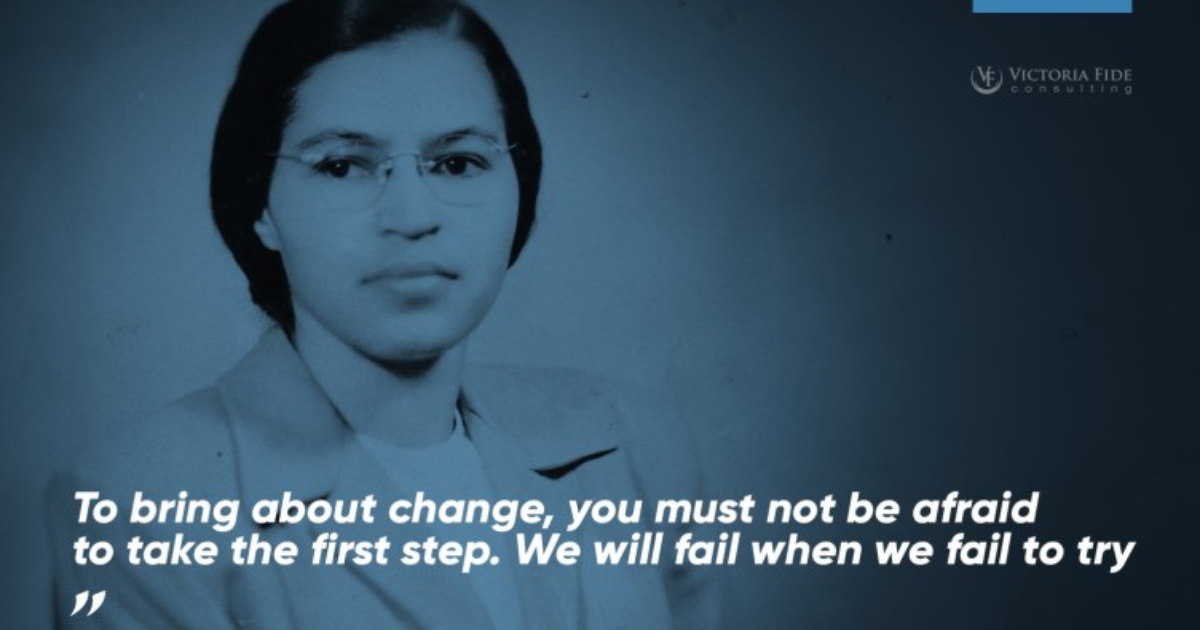
The Sage Wisdom series is produced by Victoria Fide Marketing with input and oversight from our leadership team and industry SMEs.
Rosa Parks is well-known for her significant role in the civil rights movement when she refused to give up her seat on December 1, 1955. Her courage, integrity, and ongoing actions inspired momentous change across the country, and in 1999 she was awarded the Congressional Gold Medal, the highest honor the United States bestows on a civilian.
Parks once said, “To bring about change, you must not be afraid to take the first step. We will fail when we fail to try.” This profound truth can also inform digital transformations where “analysis paralysis” threatens the very survival of the implementation. Leaders that are too focused on choosing the perfect approach can fall prey to this phenomenon and fail to take any meaningful action, resulting in stalled projects and missed opportunities. To avoid this trap, leaders should heed Rosa Parks’ advice to move past fear and take the first step.
The key to taking that first step lies in the Current Best Approach (CBA) strategy. CBA enables forward progress by focusing on practical, iterative progress rooted in current available information, while leaving room for adjustments if new information or requirements are acquired.
This article examines how adopting CBA can prevent projects from stalling and keep everyone engaged and aligned with the transformation goals. It will also provide a framework for leaders to adopt CBA in their next digital transformation. Rosa Parks’ quote reminds us that real change requires action, and the CBA strategy reinforces the importance of taking that crucial first step to drive successful digital transformation.
Analysis Paralysis: The Fear of Making the Wrong Decision
Leading a team through a digital transformation is a lot of pressure. Millions of dollars in resources, the company’s future, and even people’s livelihoods are at stake. When the pressure to make the correct decision collides with the myriad of unknown factors in the future, the result is analysis paralysis.
Analysis paralysis occurs when insufficient information impedes confident decision-making, leading individuals to remain in a state of indecision while continually collecting, scrutinizing, and deliberating over the optimal choice. This fear of moving forward can spell disaster for the company. Projects slow down, money is wasted, and your competitors move ahead. You miss opportunities because you’re too busy worrying about what could go wrong.
The Solution to Analysis Paralysis: Current Best Approach (CBA)
Current Best Approach (CBA) operates under the theory that we can never have perfect or complete information, yet decisions must be made to keep the project moving forward. With CBA, everyone recognizes that although the decision has been made and documented, it can also be adjusted if new information or requirements come to light. This allows for data-informed decision-making, continuous progress, and flexibility which eases the fear of making the wrong decision.
CBA is a straightforward, agile solution that stops analysis paralysis in its tracks. Instead of worrying about what might happen later down the road, think of it as taking the first strategic step on a path you can already see. Choosing to make the best decision with the information you have makes tackling complex challenges feel more manageable while allowing for flexibility in the future.

Transformation is not easy, but it doesn’t have to be impossible. Take control of your project’s success today and schedule a free 30-minute consultation to find out how Victoria Fide can equip you for transformational success.
3 Best Leadership Practices for CBA
Effective CBA requires timely, data-driven decision-making and effective communication in digital transformation projects.
- In DX projects, time is not on your side. The longer it takes to reach the finish line, the more resources are required to get it there. It is crucial to make decisions promptly, choosing the best approach based on current available data. This doesn’t mean decisions should be made flippantly, but rather emphasizes the importance of prioritizing data-driven decisions to avoid lengthy deliberations that can paralyze the project. Embrace the CBA mindset by weighing the available data, acting swiftly, and keeping the project moving forward.
- One of your key responsibilities as a leader is to ensure everyone is on the same page. Aligning all stakeholders and teams with the CBA strategy is paramount. This means presenting the available information, conveying the current best approach based on that information, and communicating that the approach may change if the information on which it was predicated changes. Clear and consistent communication about the CBA helps foster a shared understanding and commitment, keeping the whole team on the same page.
- Communication within a digital transformation project under the CBA approach is critical. As a leader, you can facilitate this by employing practical strategies. Encourage open dialogue among team members, listen to their concerns, and provide clarity on project goals and progress. Clear communication channels, regular updates, and transparency help maintain a collaborative environment conducive to the success of your CBA-driven digital transformation efforts.
Breaking Free from Analysis Paralysis: Embracing CBA for Success
Parks’ quote about taking the first step applies not only to history but also to digital transformation. We’ve seen how analysis paralysis can hinder progress, trapping you in the fear of making the wrong decision. That’s where the Current Best Approach (CBA) comes in – it helps you move forward, step by step, with data as your guide.
CBA prevents projects from stalling and offers a path to overcome resistance to change. It is your ally in a world where digital transformation is crucial, but time is rarely on your side. Embrace CBA as your strategy for success. Make data-informed decisions, communicate effectively, and be prepared to adapt to new information. By doing so, you’ll find that the first step isn’t so daunting after all; it is the beginning of a journey toward a brighter digital future.

Subscribe to our weekly LinkedIn Digital Transformation Success newsletter and get notified of each new edition.
